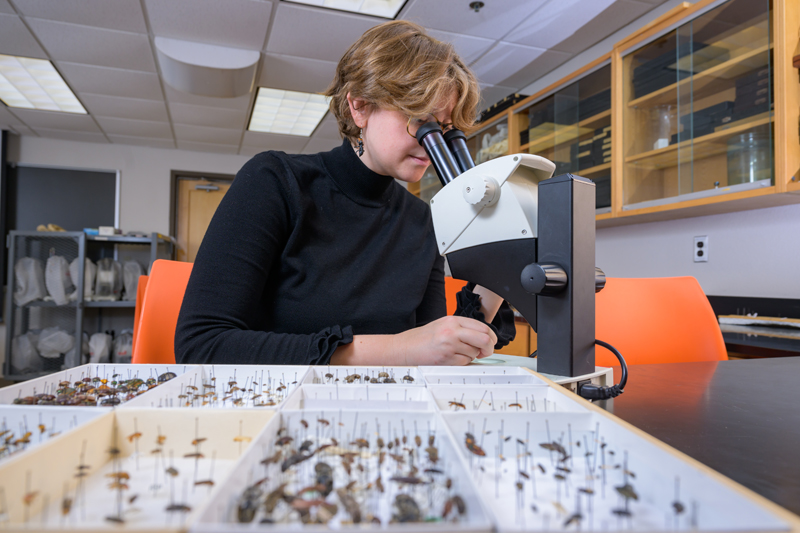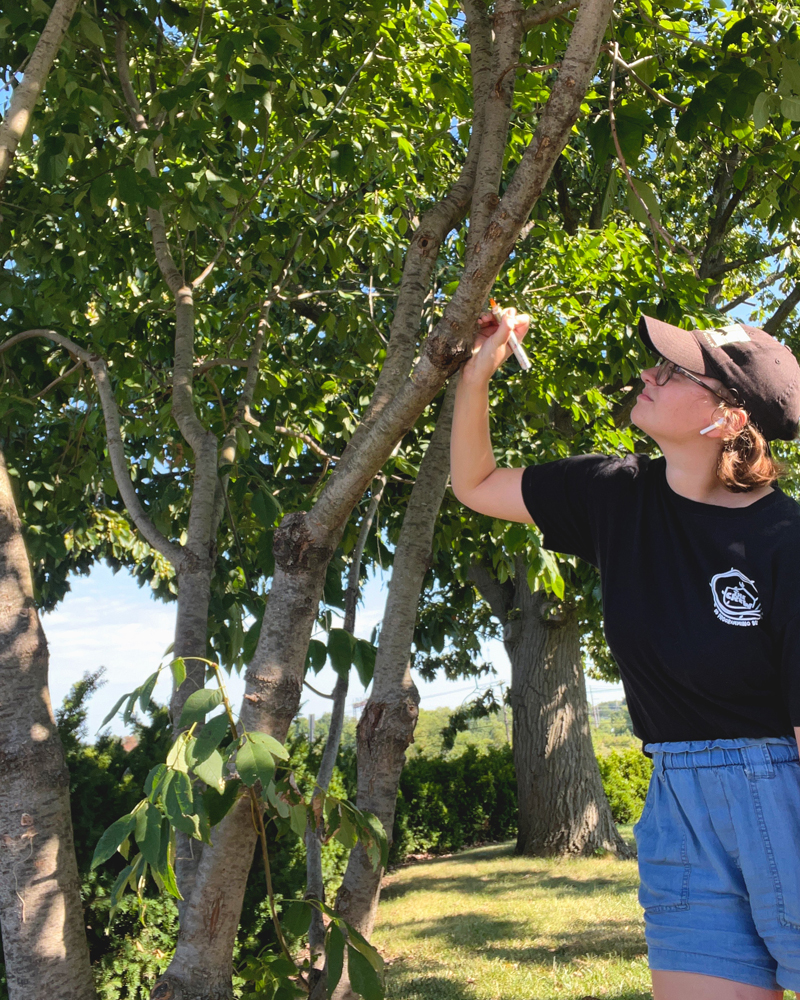


Targeting invasive species
Photos by Evan Krape and courtesy of Peyton Easton November 28, 2023
UD student Peyton Easton uses U.S. Department of Agriculture research opportunity to explore entomology and wildlife careers
Emerald ash borer (EAB) is an invasive insect species responsible for the widespread death of millions of ash trees across the country. Stopping its spread is a daunting task, but University of Delaware students like Peyton Easton are up for the challenge.
The UD senior researches these pests in the U.S. Department of Agriculture (USDA) Beneficial Insects Lab, conveniently located on UD’s main campus in Newark. Easton is part of a research team composed mainly of USDA employees, students and sponsoring professors. They study how to control these beetles.
“The goal of our lab specifically is to figure out how to mitigate further spread of these insects and to better understand as much as we can about them so we can help the ash tree population,” said Easton, an insect ecology and conservation and wildlife ecology and conservation double major and honors student.
She has been a research assistant for this ongoing project since the 2022 fall semester.
“Because it’s such a big pest in the U.S., it gets quite a bit of grant money and investment from government and schools,” Easton said. “It’s a very long-term project.”

The Dover, Delaware, resident is primarily focused on species of wasps that could eliminate EAB, as well as the potential benefits of woodpeckers. Her contributions are sponsored by UD faculty members Doug Tallamy and Debbie Delaney of the Department of Entomology and Wildlife Ecology.
“[Easton] is an amazingly bright student and her project, which looks at biocontrol of EAB, a devastating pest, will provide critical information about how biocontrol agents, mainly parasitoid wasps, find and select their hosts, and if there is a preference for EAB,” explained Delaney.
“Easton is one the most promising undergrads who have moved through our department in decades,” Tallamy said. “She is smart, efficient, mature, organized and has approached her research as if she were a mature graduate student.”
Previously, Easton practiced her professionalism as an intern at the University of Kentucky. Her first few weeks were spent as a camp counselor, working with high school students interested in wildlife, insects and forestry.
The Blue Hen and her students discussed the responsibilities of each respective field and explored how they translate into research questions. They covered skills like insect trapping, setting up wildlife cameras and capabilities as obscure and thrilling as snake wrangling.
When camp ended, Easton transitioned to the lab. She worked with graduate students on two projects — one observing alfalfa quality and another studying elk. This experience lent Easton the chance to tag a newborn elk, use radio telemetry (radio signals made of electromagnetic waves that determine the location) and analyze blood and fur samples.
“Everything that I’ve done in my classes has been able to apply directly to these jobs,” said Easton, who also minors in resource economics. “In some of my wildlife classes, we talk about camera trap techniques and different survey methods, and I was able to use those in Kentucky pretty directly.”
Back on campus, Easton stays very busy. She is an ag ambassador for the College of Agriculture and Natural Resources and an avid member of the Entomology Club, Ag Day student committee, 8-Bit Orchestra and The Crew, a programming board that coordinates student life events.
When it’s time to fly the coop, Easton is confident that the education and experiences she received at UD will influence her next step.
“I’m still deciding whether I want to pursue a more insect or a more wildlife-oriented path. I’m really passionate about both fields and there’s a lot of overlap, too, so maybe I can eventually do both,” Easton said. “But wherever that takes me, I’ll be happy.”
Contact Us
Have a UDaily story idea?
Contact us at ocm@udel.edu
Members of the press
Contact us at 302-831-NEWS or visit the Media Relations website

